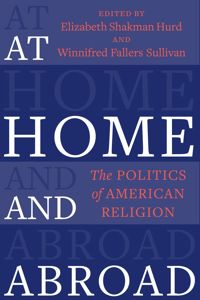
Moving Beyond Hypocrisy: Review of “At Home and Abroad”
Jennifer Graber
Photo by Alex Vasey on Unsplash.
This article is part of our “At Home and Abroad” series.
If you’d like to check out other articles in this series, click here.
In this volume about the politics of American religion, Shakman Hurd and Sullivan ask readers to consider the differences between “domestic versions of religion and religious freedom” as opposed to “those offered for export” (1). The emphasis on disestablishment and free exercise at home, they write, stands in stark contrast to American projects abroad, where the U.S. often promotes religion with an eye toward democratization (ie. civilization) and suppresses groups like the Taliban, even if these political actors display what stateside might be called “sincere” religious belief. The volume consists of comparative case studies in which looking both at “home” and “abroad” brings these varying, if not competing, religious politics into view. In so doing, the authors do more than note the troubling nature of this difference. Rather, they perform the important analytical work of situating the creation and maintenance of these differing politics in the long history of racialization and colonialism. Further, they also detail examples of what one contributor calls the “double-cross,” in which practitioners question and disrupt the categories upon which these differing politics rely.
The collection comes at an opportune time, as the scholarly conversation about the “U.S. in the world” encourages more attention to global context and has questioned some of the most problematic and durable notions of American exceptionalism. But Shakman Hurd, Sullivan, and their collaborators are up to something different. By looking at U.S. connections abroad, they see something peculiar, if not exceptional, but in unexpected places. It’s not America’s democratic politics or free market that makes it singular. Rather, it’s the very existence of the two religious politics described in the introduction. Further, the authors complicate the “U.S. in the world” conversation by showing that home and abroad are not necessarily geographical designations. Instead, as Matthew Cressler noted in his reflection, proper religion for home and abroad can be constructed in many places on the map. Abroad can be Hawaii or Puerto Rico. Home can be Israel or South Sudan.
The authors complicate the “U.S. in the world” conversation by showing that home and abroad are not necessarily geographical designations.
Because the volume calls for consideration of “abroad” in the study of “home,” I reflected on the one course I teach with a firm national home in its title: my undergraduate survey course called History of Religion in the United States. The course fulfills a core curriculum requirement in U.S. history. (To understand just how much “home” matters, students at the University of Texas at Austin must take two courses in U.S. or Texas history to graduate.) This class already extends beyond the United States, both geographically and temporally. We start in Cahokia, the thirteenth-century city at the continent’s heart. The colonial-era unit introduces Protestants, Roman Catholics, Jews, and Muslims in Europe, Africa, and the Middle East, as well as practitioners of traditional African religions. Over the course of the semester, we explore waves of immigration from around the globe, especially those after 1965.
I offer three examples of how this volume prompted me to rethink this class about home. First, Haefeli’s chapter on disestablishment. I share his opinion that the chaotic history of England’s religious landscape was a crucial factor for U.S. disestablishment. “Protestantism,“ he writes, “is not a church. It is a compromise” (27). I’m in full agreement. But Haefeli, with his attention to post-1787 events outside the new U.S., offers another way of explaining this compromise. After decades of tumult, England reinstated a consistent Anglican establishment. In time, England, once a bastion of anti-Catholicism, moved toward greater toleration, notably in Quebec. Americans howled. Its Protestant citizens had long derided Catholic authority, but diligence against “popish” advances became even more important in a religious field with no acknowledged leader. Religion, as I’ve observed with other freedoms available (to some) in the early republic, demanded inhabitants’ good choices. Haefeli neatly shows how anti-Catholic animus, as it declined in England, flourished in the disestablished U.S., as choosing “good religion” seemed vital as the U.S. sought to extend its territory and deal with streams of Catholic immigrants. Haefeli’s examination of the U.S. as a new home dealing with England, a new abroad, gives me another way to reach my students, who are genuinely baffled by anti-Catholicism so virulent as to lead to convent arson. This is not to say that anti-Catholicism is particularly American or exceptional, but rather to use comparison to explain how it persisted in the U.S. for particular reasons.

Second, Kale and Novetzke’s chapter on yoga in the U.S. and India. There’s no shortage of scholarly work on the debate over whether or not yoga is religious, and specifically Hindu, and therefore, a violation of the establishment clause if taught in public schools. In the past, I’ve fielded many student questions about this debate, typically by narrating yoga’s introduction to the U.S. by way of modernizing figures such as Vivekananda and Americans’ interest in the subcontinent, including the elements that came to be called “Hinduism.” But Kale and Novetzke offer an even more complicated (and enlightening) backstory. They focus on India’s history, showing how yoga as a “psychophysical practice” has been directed toward a variety of ends within numerous power contests (213). The form of yoga eventually exported to the U.S., presented by elite Hindus, reflected the class and religious prejudices of its place of origin. By attending to India, the authors offer an answer to my students who ask if yoga is Hindu and whether white people practicing it are guilty of cultural appropriation. People have engaged in yoga in many ways. While we might immediately think of its potential as exercise or meditation, the authors show it has also, at home and abroad, been employed for anti-colonial protest, Muslim exclusion, class distinction, Orientalist fantasy, and culture war.
Finally, Johnson’s discussion of bones and land in Hawaii. My course includes a session on Hawaii as a vector of Japanese immigration to the U.S. after annexation. This approach allows me to emphasize the Kingdom of Hawaii’s history (which is entirely new to most students), the kingdom’s agreement with the Japanese emperor to allow Japanese workers, the U.S. coup (also new to students), Japanese workers’ arrival to the mainland U.S. during a period of anti-Asian antipathy, and finally, the experience of Japanese-American Buddhists during World War II. What’s missing here, of course, is attention to the religious lives of Native Hawaiians. To my surprise, Johnson’s reflection on Hawaii’s “legal ambiguity” (as neither home nor abroad given its history, population, and politics) helped me see a connection between Native Hawaiian and Japanese-American experiences (149). Johnson details how some Native Hawaiians, as a result of their commitment to people and land, refuse to speak in the registers of the U.S. legal system. They engage, he writes, in “auto-jurisdiction,” self-authorized speaking of the law that rejects state-granted permission, language, and mechanisms (149). Particular to Native Hawaiian instances of auto-jurisdiction is care of the land (mālama ‘āina), their home. They assert their land relations and obligations as a “core Hawaiian religious tenant” in the face of state and federal laws that fail in regard to communities who recognize land as sacred (156).
We have much to learn from this volume and its attention to the particular stories of America’s two forms of religious politics: the free one for “home” and the coercive one taken “abroad.”
While it might be a stretch, I see an echo of the auto-jurisdiction Johnson describes in the Japanese-American experience I present to my class. Under President’s Franklin Roosevelt’s internment order, Japanese-Americans suffered numerous rights violations. Their right to free exercise of religion while incarcerated, however, was respected. As a result, internment camps were sites of evolving Buddhist practice. Some scholars have focused on changes during this period, describing an “Americanization” of Buddhism to make the practice more palatable. Take, for example, the 1944 founding of the Buddhist Churches of America as a prime example. What is a Buddhist “church” if not a signal of assimilation, of capitulation? But what about the “of America” in the organization’s name? In the register of the one freedom the U.S. acknowledged, the right to free religious exercise, these Japanese-Americans declared their place within the larger political body, one from which they had been forcibly segregated and unlawfully stripped of their rights. We, of Japanese descent and Buddhist practice, they insisted, are also at home in America.
As my three examples show, I think we have much to learn from this volume and its attention to the particular stories of America’s two forms of religious politics: the free one for “home” and the coercive one taken “abroad.” Some readers might stop there, throw up their hands, and gasp at the hypocrisy detailed in these chapters. But Shakman Hurd, Sullivan, and their interlocutors have asked more of their readers. I plan to hand this volume to students who – with regularity – want to write about the 1883 Code of Indian Offenses or the recent creation of the Department of State’s Office of International Religious Freedom. “It’s so hypocritical,” they say. Indeed, it is. But this charge is description, not analysis. Shakman-Hurd and Sullivan’s volume initiates the analysis we need about these differing politics. It models a conversation about the ways distinctions between home and abroad, good religion and bad, inside and outside have been created, maintained, adapted, and (thrillingly) challenged. ♦

Jennifer Graber is Professor of Religious Studies, Shive, Lindsay & Gray Professor in the History of Christianity, and Associate Director of Native American and Indigenous Studies at the University of Texas at Austin. She is the author of The Gods of Indian Country: Religion and the Struggle for the American West (Oxford 2018) and The Furnace of Affliction: Prisons and Religion in Antebellum America (UNC 2011).
Recommended Citation
Graber, Jennifer. “Moving Beyond Hypocrisy: Review of “At Home and Abroad.” Canopy Forum, July 29, 2021. https://canopyforum.org/2021/07/29/moving-beyond-hypocrisy-review-of-at-home-and-abroad/.

